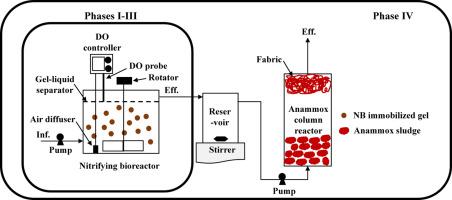Journal of Environmental Chemical Engineering ( IF 7.7 ) Pub Date : 2021-01-22 , DOI: 10.1016/j.jece.2021.105122 Dawoon Jeong , Hyunman Lim , Weonjae Kim

|
This study investigated a combined partial nitritation and anammox process for treating low-strength ammonia synthetic wastewater (~50 mg-NH4+-N/L) at 20°C. The nitrifying bioreactor consisted of immobilized nitrifying bacteria in poly(vinyl alcohol) gel beads, which was operated under limited dissolved oxygen (DO) concentrations of 0.3–0.5 mg-O2/L to suppress nitrite-oxidizing bacteria (NOB) activity. The temperature in the nitrifying bioreactor decreased from 35 to 20°C, and the hydraulic retention time (HRT) was shortened from 6 h to 3 h. The limited DO concentration enabled partial oxidation of ammonia to nitrite (55.8%), but an undesired nitrite oxidation rate of 31.5% was observed at 20°C. The changes in bacterial community structure in response to the different operating conditions were observed by high-throughput 16 S rRNA gene sequencing analysis. The lowered temperature resulted in a significant shift in the bacterial community structure, while the effect of HRT was negligible. Nitrosomonas ureae and Nitrospira moscoviensis played critical roles in nitrification at low DO concentrations. Interestingly, a high nitrogen-removal efficiency of 71.4% was achieved in the integrated nitrifying bioreactor and anammox at 20°C despite incomplete NOB suppression in the nitrifying bioreactor. Denitratisoma oestradiolicum and Petrimonas sp., which are capable of nitrate reduction, were dominant in the anammox reactor, which might allow the provision of additional nitrite for the anammox reaction. The number of Candidatus Jettenia asiatica decreased in response to the lowered temperature, while the population of Candidatus Brocadia sinica increased.
中文翻译:

20℃下部分硝化与厌氧氨氧化(厌氧氨)相结合处理低氨废水
这项研究调查了部分硝化和厌氧氨氮联合工艺在20°C下处理低强度氨合成废水(〜50 mg-NH 4 + -N / L)。硝化生物反应器由固定化的硝化细菌组成,该细菌固定在聚乙烯醇凝胶珠中,可在0.3-0.5 mg-O 2的有限溶解氧(DO)浓度下运行/ L可抑制亚硝酸盐氧化细菌(NOB)的活性。硝化生物反应器中的温度从35℃降至20℃,水力停留时间(HRT)从6 h缩短至3 h。有限的DO浓度能够使氨部分氧化为亚硝酸盐(55.8%),但是在20℃下观察到不希望的亚硝酸盐氧化率为31.5%。通过高通量16 S rRNA基因测序分析观察到细菌群落结构响应不同的操作条件的变化。降低的温度导致细菌群落结构发生明显变化,而HRT的影响可忽略不计。脲亚硝化单胞菌和莫斯科硝化螺旋藻在低溶解氧浓度下在硝化中起关键作用。有趣的是,尽管硝化生物反应器中的NOB抑制不完全,但集成的硝化生物反应器和厌氧氨氮在20°C时仍能达到71.4%的高脱氮率。Denitratisoma oestradiolicum和Petrimonas属,其能够还原硝酸盐,分别在Anammox反应器的,这可能会允许厌氧氨氧化反应额外亚硝酸盐的提供优势。的数量暂定Jettenia草响应于降低的温度降低,而人口暂定Brocadia蛉增加。



























 京公网安备 11010802027423号
京公网安备 11010802027423号